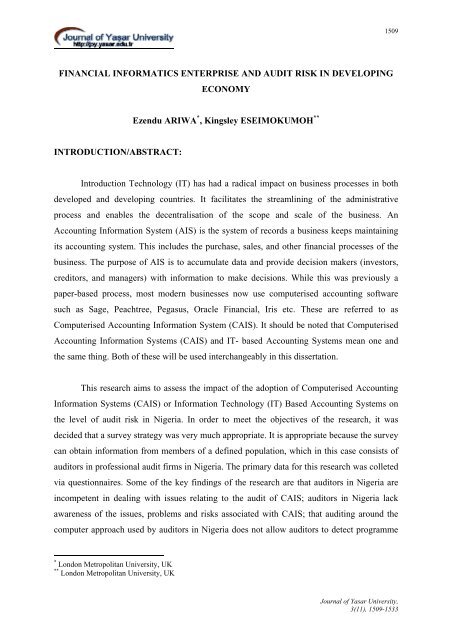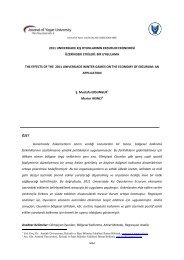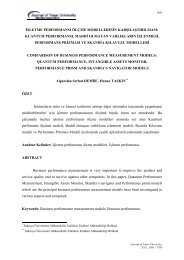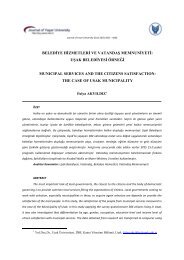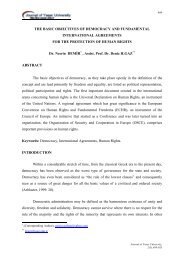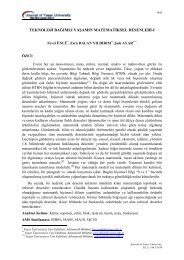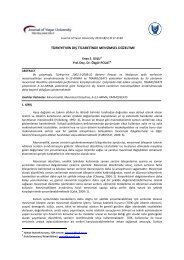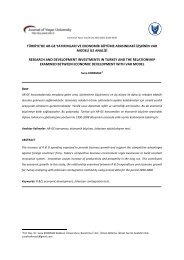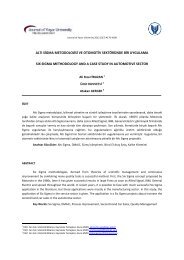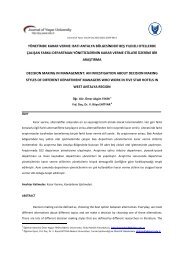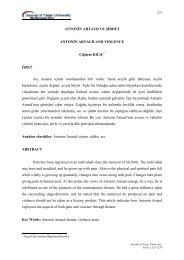FINANCIAL INFORMATICS ENTERPRISE AND AUDIT RISK IN ...
FINANCIAL INFORMATICS ENTERPRISE AND AUDIT RISK IN ...
FINANCIAL INFORMATICS ENTERPRISE AND AUDIT RISK IN ...
You also want an ePaper? Increase the reach of your titles
YUMPU automatically turns print PDFs into web optimized ePapers that Google loves.
1509<strong>F<strong>IN</strong>ANCIAL</strong> <strong><strong>IN</strong>FORMATICS</strong> <strong>ENTERPRISE</strong> <strong>AND</strong> <strong>AUDIT</strong> <strong>RISK</strong> <strong>IN</strong> DEVELOP<strong>IN</strong>GECONOMYEzendu ARIWA * , Kingsley ESEIMOKUMOH **<strong>IN</strong>TRODUCTION/ABSTRACT:Introduction Technology (IT) has had a radical impact on business processes in bothdeveloped and developing countries. It facilitates the streamlining of the administrativeprocess and enables the decentralisation of the scope and scale of the business. AnAccounting Information System (AIS) is the system of records a business keeps maintainingits accounting system. This includes the purchase, sales, and other financial processes of thebusiness. The purpose of AIS is to accumulate data and provide decision makers (investors,creditors, and managers) with information to make decisions. While this was previously apaper-based process, most modern businesses now use computerised accounting softwaresuch as Sage, Peachtree, Pegasus, Oracle Financial, Iris etc. These are referred to asComputerised Accounting Information System (CAIS). It should be noted that ComputerisedAccounting Information Systems (CAIS) and IT- based Accounting Systems mean one andthe same thing. Both of these will be used interchangeably in this dissertation.This research aims to assess the impact of the adoption of Computerised AccountingInformation Systems (CAIS) or Information Technology (IT) Based Accounting Systems onthe level of audit risk in Nigeria. In order to meet the objectives of the research, it wasdecided that a survey strategy was very much appropriate. It is appropriate because the surveycan obtain information from members of a defined population, which in this case consists ofauditors in professional audit firms in Nigeria. The primary data for this research was colletedvia questionnaires. Some of the key findings of the research are that auditors in Nigeria areincompetent in dealing with issues relating to the audit of CAIS; auditors in Nigeria lackawareness of the issues, problems and risks associated with CAIS; that auditing around thecomputer approach used by auditors in Nigeria does not allow auditors to detect programme* London Metropolitan University, UK** London Metropolitan University, UKJournal of Yasar University,3(11), 1509-1533
<strong>F<strong>IN</strong>ANCIAL</strong> <strong><strong>IN</strong>FORMATICS</strong> <strong>ENTERPRISE</strong> <strong>AND</strong> <strong>AUDIT</strong> <strong>RISK</strong> <strong>IN</strong> DEVELOP<strong>IN</strong>G ECONOMY1510errors that do not show up in the computer reports; that the disappearance of the audit trailmakes it difficult, if not impossible, for the auditor to follow the processing in a particularapplication area etc.Information Technology (IT) has had a huge impact in the developed world. Itfacilitates the streamlining of the administrative process and enables the decentralisation ofthe scope and scale of the business. Businesses are harnessing the advantages of using IT dueto harsh competition from rivals, financial pressures to lower operating expenses and theimpact of globalization. This study seeks to examine the impact of the adoption ofinformation technology on the audit risk in Nigeria.The aim of this paper is to introduce the research problem undertaken in this study.The second section provides a background to the research problem; the third section explainsthe rationale for the research; section four includes the research question; section five containsthe research aims; and section six outlines the research objectives.Background to the Research ProblemIntroduction Technology has had a radical impact on business processes in bothdeveloped and developing countries. It plays a major role in many, if not most, of theeveryday operations of today’s business world. This advancement in technology has fosteredthe creation of computerised accounting information systems, which enables accounting tasksto be accomplished with increased speed and accuracy. An accounting information system isthe systems of records a business keeps to maintain its accounting systems. This includespurchases, sales and other financial processes of the business.About a decade ago, the accounting systems in many businesses in Nigeria weremostly manual, for example financial records were manually maintained (paper-based), butwith the increased growth in the usage of computerised information accounting systems inNigeria and the increased risk posed by such systems such as accidental and intentional entryof bad data, organised fraud etc, the main question is if the audit risk placed by auditors onbusinesses using these systems have changed due to the increased usage of these systems.Ariwa, Eseimokumoh, 2008
1511The research aims to assess if there has been significant changes in the level of audit riskplaced by auditors on particular businesses due to the adoption of computerised accountinginformation systems.Rationale for the researchThere has been a significant increase in the number of companies and businesses thathave adopted Computerised Accounting Information Systems (also referred to as InformationTechnology Based Accounting Systems) into their day-to-day activities. The advantages ofthese systems in modern day business cannot be over-emphasised. This has created a newaudit environment, which is very different from the traditional environment, in whichaccounting processes and systems were predominately paper based and manual. This newcomputerised systems has created new audit environment which has different attributes to thetraditional one. Hence there is the need to examine the level of audit risk after the adoption ofthese computerised accounting information systems.There are a number of reasons that makes me want to embark on this dissertation. Ihave mentioned some of these below:The final research presented to the university will be in partial fulfilment for the awardof a masters’ degree in computer systems auditing.It will also improve my awareness of issues relating to the use of computerisedaccounting information systems in Nigeria.The results of this research study might be useful to audit firms, whose clients’ haveadopted computerised accounting information systems, by providing an insight into the risksassociated with such accounting systems. Hence allowing these firms to provide ways ofmitigating these risks and improving the quality of audit in Nigeria.Journal of Yasar University,3(11), 1509-1533
<strong>F<strong>IN</strong>ANCIAL</strong> <strong><strong>IN</strong>FORMATICS</strong> <strong>ENTERPRISE</strong> <strong>AND</strong> <strong>AUDIT</strong> <strong>RISK</strong> <strong>IN</strong> DEVELOP<strong>IN</strong>G ECONOMY1512Research QuestionHas the adoption of computerised accounting information systems in businesses inNigeria affected the level of audit risk?Research Aim:To assess the impact of the adoption of computerised accounting information systemson the level of audit risk in Nigeria.Research Objectives:The following consists of the research objectives of this paper:To assess the extent to which the accounting systems in companies and businesses arecomputerised in Nigeria.To evaluate the possible problems that are associated with auditing in a computerisedaccounting information system based environment in Nigeria.To evaluate the impact of computerised accounting information systems on the levelof audit risk, whether the audit risk has significantly changed (increased) after the adoption ofthese computerised accounting information systems by clients in Nigeria.LITERATURE REVIEWThis research will aim to provide the reader with a literature review of the differentaspects of Computerised Accounting Information Systems (also referred to as IT-basedaccounting systems) and its impact on the audit risk. The discussion will commence with alook at the definition of Computerised Accounting Information System and the types of ITbasedaccounting systems in use in businesses. The discussion will then go on to lookextensively at the differences between CAIS and manual accounting systems; the types ofauditors and the different kinds of audit activities. Also covered in the literature review is avery descriptive definition of internal control; the various types of internal controls in an ITAriwa, Eseimokumoh, 2008
1513based environment; a highly descriptive account of audit risks and its components and finallythe potential risks that are associated with auditing in an IT- based audit environment.Definition of Information Technology (IT)Information is more than just news; it has been defined as knowledge, facts, figures,data, intelligence, ideas, etc essential for planning and development (Adimorah, 1977).According to Burch and Grudnitski (1986), developmental information must have threeattributes consisting of accuracy, timeliness and relevance. If information is to fulfill theseattributes, it requires in almost all cases to be processed and repackaged in a format that willallow for its quick, clear and maximum utilisation. This cannot be actualised through manualprocesses. In response to this inherent incapacity, various technologies have been invented forthe management of information resources. It is these that are referred to as informationtechnologies. According to Moll (1983), IT refers to the various technologies used in thecreation, acquisition, storage, dissemination, retrieval, manipulation and transmission ofinformation. Information Technology is rapidly changing the global business market. It isaltering not only the way in which business is conducted, but also the way in whichinformation is accessed (Cosserat, 2000).Information Technology (Early Development)Modern computers, as we understand, were essentially designed and developed in theUnited States half a century ago. At the end of the twentieth century and the dawn of thetwenty-first century, a new revolution had just begun to shape the context of humancivilisation. It was called the “information revolution”. Basically propelled by the gains of theindustrial revolution and advances in technology, the information revolution is the result of aconvergence between information and communications technologies.The worlds’ first fully automatic computer is considered to be the MARK1, which wasset in operation in 1944. Sometime during the 1950s’, the potential of computers in the realmJournal of Yasar University,3(11), 1509-1533
<strong>F<strong>IN</strong>ANCIAL</strong> <strong><strong>IN</strong>FORMATICS</strong> <strong>ENTERPRISE</strong> <strong>AND</strong> <strong>AUDIT</strong> <strong>RISK</strong> <strong>IN</strong> DEVELOP<strong>IN</strong>G ECONOMY1514of business was recognised, and a powerful impetus was now given to marry technology andcommerce (Mukherji, 2000).According to Lynch and Rice (1975), the period from 1956 to 1958 saw threesignificant developments in computing. These wereBreakthroughs in increased core memoriesDevelopment of more standardised and higher level languagesThe development of a system for operating a computer or the operating system.Information Technology in Businesses in Developed CountriesInformation Technology has had a huge impact in the developed world. It facilitatesthe streamlining of the administrative process and enables the decentralisation of the scopeand scale of the business.According to Chan (2000), Table 1 below illustrates how Information Technology (IT)has influenced business processes in the developed world.Ariwa, Eseimokumoh, 2008
1515CapabilityAutomationAnalyticalDisintermediationGeographicalImpact and BenefitIT can replace or reduce human labor in a processIT can improve analysis of information and decisionmakingIT can be used to connect two parties within a process andeliminate intermediaries from a processIT can transfer and coordinate information with rapidityand ease across large distances, making processesindependent of geographyInformationalIntegrativeIntellectualKnowledge managementSequentialIT can capture vast amounts of detailed processinformation for purpose of understandingIT can coordinate tasks and processesIT can capture and distribute intellectual assetsIT allows the capture and dissemination of knowledge andexpertise to improve the processIT can enable changes in the sequence of tasks in aprocess, often allowing parallelismSource: Information Technology in Business Processes, Business Process ManagementJournal, Vol. 6, No.3, pp. 224-237.The use of IT in developed countries has propelled the economies of these countries,ranging from investment banks, financial institutions and even the public sector, that theabsence of these systems or the failure of these systems will cause major disruptions tobusiness processes.Information Technology in NigeriaInformation Technology is often recognised as a powerful agent for social andeconomic change. Nigeria had a late start in the use of computers; the growth in its usage hasbeen quite remarkable. A tremendous impetus was given to the computer market by thegrowing interest in microcomputers in the past decade.Journal of Yasar University,3(11), 1509-1533
<strong>F<strong>IN</strong>ANCIAL</strong> <strong><strong>IN</strong>FORMATICS</strong> <strong>ENTERPRISE</strong> <strong>AND</strong> <strong>AUDIT</strong> <strong>RISK</strong> <strong>IN</strong> DEVELOP<strong>IN</strong>G ECONOMY1516The computer installations are widely distributed in universities, governmentdepartments and agencies, banks, commercial establishments, and industries. It must berealised that the private sector has, however, risen to a position of dominance in the use ofcomputers especially the banking and the oil and gas industries. In summary, the growth inthe use of computers in businesses in Nigeria has been phenomenon.Definition of Computerised Accounting Information System (Information Technology– Based Accounting Systems)It should be noted that Computerised Accounting Information Systems (CAIS) andInformation Technology (IT) - based Accounting Systems mean one and the same thing. Bothof these will be used interchangeably in this research paper.An Accounting Information System (AIS) is the system of records a business keeps tomaintain its accounting system. This includes the purchase, sales, and other financialprocesses of the business. The purpose of AIS is to accumulate data and provide decisionmakers (investors, creditors, and managers) with information to make decisions. While thiswas previously a paper-based process, most modern businesses now use accounting softwaresuch as Sage, Peachtree, Pegasus etc.According to Lanier (1992), an IT- based accounting system is:‘‘ a set of organised procedures used to collect and record accounting data with theuse of a computer’’.The rapid change in information technology, the wide spread of user-friendly systemsand the desire of organisations to acquire and implement up-to-date computerised systems andsoftware have made computers much easier to use and enabled accounting tasks to beaccomplished with increased speed and accuracy (Al-Fehaid, 2003).Ariwa, Eseimokumoh, 2008
1517Types of IT – Based Accounting SystemsThere are two types of IT-based accounting systems. These consist of:Integrated Accounting Systems andStand Alone Accounting Systems (Dodd, 1992; Lanier, 1992; Fardon, 2002).According to Lanier (1992), integrated accounting systems are systems in which twoor more accounting modules are used together and share information between each other. Amodule is a program that is written to perform only a specific accounting function such asaccounting receivable processing and may be able to communicate with other modules. Inother words, in such a system each module handles a separate function but also communicatewith the other modules.A stand-alone accounting system can be defined as a system in which only one module is used(Lanier, 1992).The usage of the integrated accounting system or the stand-alone accounting system ina business depends on a load of factors such as the frequency of transactions, staff knowledgeand skill, and the size of the business (Dodd, 1992; Lanier, 1992; Fardon, 2002).The Differences between Computerised Accounting Information Systems (CAIS) and ManualAccounting Systems.It is important to consider the differences between computerised accountinginformation systems and manual accounting systems. There are essential differences betweenmanual and IT-based accounting systems which auditors should take into account, especiallywhen they perform their tasks in an IT-based accounting environment (Rezaee and Reinstein,1998; Grays and Manson, 2000; Taylor and Glezen, 1994). The following consists of some ofthe important differences that have been recognised:Journal of Yasar University,3(11), 1509-1533
<strong>F<strong>IN</strong>ANCIAL</strong> <strong><strong>IN</strong>FORMATICS</strong> <strong>ENTERPRISE</strong> <strong>AND</strong> <strong>AUDIT</strong> <strong>RISK</strong> <strong>IN</strong> DEVELOP<strong>IN</strong>G ECONOMY1518The human being who operates a manual accounting system can react intelligently tovarious events that affect the organisation while IT-based accounting systems can only act inan apparently intelligent way if they are only programmed to do so (Gray and Manson, 2000).This inadvertently means that manual systems are more flexible than IT-based accountingsystems.Random errors associated with manual processing are much more numerous thanthose which are associated with IT-based accounting systems since IT-based accountingsystems always process items in the same way (Gray and Manson, 2000).Lack of documentation is a significant problem in many computer installations.Without adequate documentation, the audit trail may disappear and the auditor may find itdifficult, if not impossible, to follow the processing in a particular application area (Watneand Turney, 1990).The potential for observing errors or fraud in IT-based accounting systems is less thanin manual accounting systems (Cosserat, 2000). This is because, in the IT-based accountingsystems, data is stored in a machine-readable form rather than a visible form which could bedeliberately accessed and altered through computer facilities on different sites (Wasik, 1991).Also, the reduced number of staffs involved in handling computer transactions can lead to theobscuring of errors, which would be more easily discovered where information anddocuments are dealt with manually.Managers and Auditors who deal with IT-based accounting systems can be providedwith a wider and more up to date variety of information than those who deal with manualsystems (Taylor and Glezen, 1994). This will ensure that the operations of the business arerun effectively and efficiently.Transactions in manual systems are usually authorised before they are executed andrecorded (Coserat, 2000). However, this is not always the case in IT-based accountingsystems where some transactions are automatically executed and recorded withoutmanagement explicit authorisation. (Rezaee and Reinstein, 1998; Taylor and Glezen, 1994).Ariwa, Eseimokumoh, 2008
1519According to Al-Fehai (2003), the adoption of IT based accounting systems by clientshas reduced certain problems such as human errors. However, it creates new challenges orrisks for auditors such as the possibility of errors in programming, the loss of audit trail, thelack of segregation between duties etc.What is Auditing?An audit is an investigation or a search for evidence to enable an opinion to be formedon the truth and fairness of financial and other information by a person or personsindependent of the preparer and persons likely to gain directly from the use of theinformation, and the issue of a report on that information with the intention of increasing itscredibility and therefore its usefulness (Gray and Manson, 2005).Types of AuditorsThese are the individuals who perform the audit. There are classified into three groups:external auditors (also called independent auditors), internal auditors and government auditors(Cosserat, 2000).RESEARCH METHODOLOGYThis research aims to assess the impact of the adoption of computerised accountinginformation systems on the level of audit risk in Nigeria. It will evaluate the impact ofcomputerised accounting information systems on the level of audit risk, whether the audit riskhas significantly changed after the adoption of these computerised accounting informationsystems by clients in Nigeria.For the purpose of this research work, it was decided that a survey was very muchappropriate. It is appropriate because the survey can obtain information from members of adefined population, which in this case consists of auditors in professional services firms inNigeria.The primary data for this research was colleted via questionnaires. Questionnaires arebased on the positivist school of research philosophy.Journal of Yasar University,3(11), 1509-1533
<strong>F<strong>IN</strong>ANCIAL</strong> <strong><strong>IN</strong>FORMATICS</strong> <strong>ENTERPRISE</strong> <strong>AND</strong> <strong>AUDIT</strong> <strong>RISK</strong> <strong>IN</strong> DEVELOP<strong>IN</strong>G ECONOMY1520Research Design: EpistemologyThere are two major epistemological orientations, consisting of positivism andinterpretivism. There are several variations within each orientation. The key difference inthese views arises from their different conceptions of human beings and how their behaviourcan be understood. These conceptions reflect different ontological assumptions about thenature of the world (Thomas, 2004). Auguste Comte (1798-1857) intended positivism to referto an approach to knowledge which restricts itself to observable facts and their relationshipsand which excludes reference to non-observable entities such as ‘gods’, ‘essence’, ‘firstcauses’ or ‘ultimate ends’. Interpretivism requires the researcher to seek to understand thesubjective reality of participants in the study in order to understand their actions andintentions in a way that is meaningful for theses research participants (Saunders et al, 2003).Research Philosophy:This research is a piece of Positivist work. This is so because the research will berestricted to observable facts relating to the adoption of computerised accounting informationsystems and the impact of these systems on the audit risk. This is similar to a cause and effectrelationship. More specifically, this research is positivist because of the followingcircumstances:The general approach of the research methodology relating to the acquisition of data,which supports the positivist realm. For example the usage of self completion questionnaires,structured face to face interviews etcData is given by the respondents, which will be collected through the means explainedabove, and are not constructed via interpretations.The research will involve quantitative measurements of the data collected.General Research Approach:Ariwa, Eseimokumoh, 2008
<strong>F<strong>IN</strong>ANCIAL</strong> <strong><strong>IN</strong>FORMATICS</strong> <strong>ENTERPRISE</strong> <strong>AND</strong> <strong>AUDIT</strong> <strong>RISK</strong> <strong>IN</strong> DEVELOP<strong>IN</strong>G ECONOMY1522This research utilised questionnaires as the main research method. However, beforehighlighting the procedures that were followed in order to design the questionnaire, it is worthdefining the term. The questionnaire has been defined by Sekaran (1992) as:“ A pre-formulated written set of questions to which respondents record their answers,usually within rather closely defined alternatives”.According to Burns (2000):“A questionnaire is a method for drawing out, recording and collecting informationand is useful when the researcher wishes to gather large amount of factual and simplisticdata that can be quantified and made into statistical evidence”Questionnaires are an efficient data collection mechanism when the research knows exactlywhat is required and how to measure the variables of interest. Questionnaires can beadministered personally or mailed to the respondents, or electronically distributed. A goodquestionnaire should include both positively and negatively worded questions (Sekaran,2000).Type of Questionnaire:The study used a combination of both:Personally Administered Questionnaires andMail questionnaires.Personally Administered Questionnaires:Personally administered questionnaire is a good way to collect data. The main advantagesconsists of:The researcher can collect all the completed responses within a short period of time.It is also less expensive.It is less time consuming than interviewing.It does not require as much skills to administer the questionnaire as to conduct the interview(Sekaran, 2000).A good proportion of the questionnaires used for this research, about thirty percent (30%),were personally administered to the respondents at the selected audit firms in Nigeria.Mail Questionnaire:The questionnaires are mailed to the respondents, who can complete them at their ownconvenience, in their homes, at their own pace. This study also used mail questionnaires. Amail questionnaire has the following advantages:It permits wide geographic contact at minimal cost.It can be used in contacting a large number of people.Ariwa, Eseimokumoh, 2008
1523It avoids researcher bias.It avoids the difficulty of making arrangements for setting appointments with intendedparticipants, as is the case in conducting face-to-face interviews.The main disadvantages of this method consists of:It has a low return rate.The difficulty of clarifying doubts the respondents may have. (Sekaran 1992; Franfort-Nachmias and Nachmias, 1992).About 70% of the questionnaires used in this study were mail-based questionnaires. Theresearch paper used a higher proportion of mail questionnaires because:Due to the wide geographical area to be covered, it would be virtually impossible to travelaround the country and personally administer the questionnaires to respondents. It was easierto mail the questionnaires to the respondents and include self-addressed stamped envelopes toimprove response rate.It is inexpensive, due to the fact that printing cost is minimal.The Structure of the Questionnaire:The questionnaire has four sections. The sections and the questions were constructed tomeasure the variables of interest. The questionnaire was structured in a simple manner, inother to make sense to the respondents. The four sections have been described briefly below:Section One: This section starts by defining Computerised Accounting InformationSystems (CAIS) and seeks to gain additional background information about the auditorsparticipating in the survey. The information sought includes the number of years worked inthe organisation, the job status of the respondent, the number of audit assignments theparticipant has been involved in the past fifteen months and the proportion of clients who usecomputerised accounting information systems.Section Two: This section of the questionnaire was designed to explore therespondents’ perceptions of the possible and potential problems that might hinder them duringan audit engagement in a client’s computerised accounting information system environment.Section Three: This section of the questionnaire seeks to understand the auditorsacquaintance with International Auditing Standards (IAS) 315: Understanding the Entity andits Environment and Assessing the Risk of Material Misstatements and goes further to assessJournal of Yasar University,3(11), 1509-1533
<strong>F<strong>IN</strong>ANCIAL</strong> <strong><strong>IN</strong>FORMATICS</strong> <strong>ENTERPRISE</strong> <strong>AND</strong> <strong>AUDIT</strong> <strong>RISK</strong> <strong>IN</strong> DEVELOP<strong>IN</strong>G ECONOMY1524the potential problems that might affect the application of the auditing standard during anaudit engagement.Section Four: This section of the questionnaire was divided into two parts. The first partcontains a list of factors, which could contribute to changes in the overall level of audit risk ina computerised accounting information system environment. The second part of section fourrequests respondents to rank the factors, which were mentioned in the first part, according tothe level of contribution to the audit risk.In conclusion, the questionnaire consists of both open-ended questions and closed questions.The open-ended questions consists of questions that would obtain demographic data from therespondents such as job level, number of years in organisation etc. These data will help todescribe the sample characteristics while writing the report after data analysis. Most of theclosed-ended questions employed the 5-point Likert scale.SUMMARY OF F<strong>IN</strong>D<strong>IN</strong>GS <strong>AND</strong> CONCLUSIONThe primary aim of this research was to investigate the impact of the adoption of ITbasedaccounting systems by clients of audit firms in Nigeria. The purpose of this research isto conclude the research study by briefly summarising the major findings obtained in light ofthe aims and objectives of the research.Summary of Findings and ConclusionOne of the major findings of this research is that approximately 58.1 percent of therespondents confirmed that over 80 percent of their clients use Computerised AccountingInformation Systems (CAIS) or Information Technology (IT) – Based Accounting Systems intheir businesses. The respondents all acknowledged the fact that a major proportion of theirclients’ used Computerised Accounting Information Systems (CAIS). This finding supportsthe researchers’ conviction regarding the necessity to investigate the adoption of thesesystems by clients and the impact of theses systems on the level of audit risk in Nigeria.The research discovered that contrary to the literature review that the following undermentionedproblems, which are associated with auditing in a Computerised AccountingAriwa, Eseimokumoh, 2008
1525Information System (CAIS) or Information Technology (IT) Based Accountingenvironment, are not an issue in Nigeria. For exampleThe use of unsuitable and unreliable accounting software by clients. (Muggridge andTroth, 1994; Silltow 2003; Blewett and Jarvis, 1989).The incompetence of client staffs’ in dealing with issues relating to CAIS for example theaccidental entry of bad data by employees, being unable to harness the advantages of CAIS inbusinesses etc. (Bell et al., 1998; Wood, 2002)Information Technology (IT) Related Fraud (Wasik, 1991; Christy, 1995).Possible reduction in internal control processes and procedures due to the introduction ofCAIS in businesses (Gwiliam, 1987)It is worth mentioning that this research is also different in the sense that it reveals thefollowing findings relating to the potential risks associated with auditing in a CAIS or ITbasedaccounting environment in Nigeria:The application of an unsuitable audit approach (i.e. auditing around the computer),which is mainly used in Nigeria, can be a potential source of audit risk in a CAISenvironment.Financial losses due to internal and external CAIS security breaches are not an issue inNigeria.According to Wasik (1991) and Christy (1995), CAIS or Information Technology (IT)- based accounting systems are more easily manipulated fraudulently than manual accountingsystems especially in advanced systems. The finding of this research shows that InformationTechnology (IT) Related Fraud is not an issue in the environment of CAIS in Nigeria.The use of CAIS has not in any way affected the level of internal control in businessesin Nigeria. This is contrary to what the literature that says that the introduction of IT-basedaccounting systems may have an adverse impact on internal controls (Gwilliam, 1987). Insummary, weaknesses in internal control systems in relation to CAIS doesn’t seem to be anissue in the environment of CAIS in Nigeria.Journal of Yasar University,3(11), 1509-1533
<strong>F<strong>IN</strong>ANCIAL</strong> <strong><strong>IN</strong>FORMATICS</strong> <strong>ENTERPRISE</strong> <strong>AND</strong> <strong>AUDIT</strong> <strong>RISK</strong> <strong>IN</strong> DEVELOP<strong>IN</strong>G ECONOMY1526International Auditing Standard (IAS) 315: Understanding the Entity and itsEnvironment and Assessing the Risk of Material Misstatements is too complicated comparedwith the level of the adoption of CAIS in businesses in Nigeria, for example being toocomplex for Nigeria.Some of the results of this study are supported, to some extent, by the potential risks inan IT-Based accounting environment discussed in the literature review section of thisdissertation. However, some of the findings that are very unique to Nigeria includes thefollowing that:Practicing auditors in Nigeria are incompetent in dealing with issues relating to theaudit of CAIS or Information Technology (IT) Based Accounting Systems. According to theliterature, effective implementation of CAIS or IT–based accounting systems requirescompetent staffs (Bell et al., 1998; Wood, 2002).Practicing auditors in Nigeria lack awareness of the issues, problems and risksassociated with CAIS.The auditing around the computer approach used by auditors in Nigeria does not allowauditors to detect programme errors that do not show up in the computer reports.The disappearance of the audit trail makes it difficult, if not impossible, for the auditorto follow the processing in a particular application areaThe research question of this paper aims to ascertain if the adoption of computeraccounting information systems in businesses in Nigeria has affected the level of audit risk?The answer to this question is yes. In light of the research findings that have been reported inresearch four, it can be concluded that the adoption of CAIS in Nigeria has contributed toincreasing the audit risk. This can be explained, on the one hand, by the existence of a numberof risks in the clients’ IT based accounting environment, such as the lack of competence ofauditors in auditing IT-based accounting system and their lack of awareness of the problemsand risks associated with such systems; the auditing around the computer approach to auditingAriwa, Eseimokumoh, 2008
1527in businesses, where auditors examine input and output only and where the processing stagewithin the computer is ignored; and the disappearance of the audit trail thereby making itdifficult, if not impossible, for the auditor to follow the processing in a particular applicationarea.Journal of Yasar University,3(11), 1509-1533
<strong>F<strong>IN</strong>ANCIAL</strong> <strong><strong>IN</strong>FORMATICS</strong> <strong>ENTERPRISE</strong> <strong>AND</strong> <strong>AUDIT</strong> <strong>RISK</strong> <strong>IN</strong> DEVELOP<strong>IN</strong>G ECONOMY1528REFERENCES:Abu - Musa, A. A. (2006), ‘‘Exploring Perceived Threats of Computerised AccountingInformation Systems in Developing Countries: The Case of Saudi Arabia’’, ManagementAuditing Journal, Vol. 2, No.4, pp 387-407.Al-Fehaid, A.M. (2003) “An Investigation of the Influence of Information Technology onAudit Risk: An Empirical Study in Saudi Arabia, Loughborough University, UnitedKingdom.Adimorah, E. (1977), “Information needs and information transfer of Nigeria soil scientists”,MLS thesis, University of Ibadan.Balsley, R. L., & Clover, V. T. (1988), Research for Business Decisions: Business ResearchMethods, 4 TH Edition, Publishing Horizons, Columbus.Burch, J. & Grudnitski, G. (1986), Information Systems: Theory and Practice, 4th edition,Wiley, New York, NY.Bell, T. B., Knechel, W. R., Payne, J. L. (1999),”Audit Risk Attribute In ComputerizedEnvironment”, The Review of Accounting Information Systems, Vol. 3, No. 2, pp.27-39.Bell, T. B., Knechel, W. R., Payne, J. L. & Willingham, J.J. (1998),”An EmpiricalInvestigation of the Relationship Between the Computerization of Accounting Systems andthe Incidences and Size of Audit Differences”, Auditing: A Journal of Practice & Theory,Vol. 17,No. 1,pp 13-38.Blewett, F. & Jarvis, R. (1989), Microcomputers in Accounting”, Van Nostrand Reinhold(International), London.Brown, W. and Nasuti, F. (2005) ‘’What ERP systems can tell us about Sarbanes-Oxley’’Available at: www.emeraldinsight.com/0968-5227.htmAriwa, Eseimokumoh, 2008
1529Bourque, L. B. & Fielder, E. P. (2003), How to Conduct Self-Administered and Mail Surveys,Sage Publications, USA.Burns, R.B. (2000) Introduction to Research Methods, 4 th Edition, Sage Publications, London.Chan, S. L. (2000), Information Technology in Business Processes, Business ProcessManagement Journal, Vol. 6, No.3, pp. 224-237.Christy, C. (1995), “Computer Fraud on the Rise”, The Internal Auditor, Vol. 52, No. 2, pp.8-9.Comer, M. (1998), Corporate Fraud, 3 rd Edition, Gower Publishing Limited, England.Cosserat, G. (2000), Modern Auditing, John Wiley & Sons, West Sussex, England.Cosserat, G. (2004), Modern Auditing, 2 ndEngland.Edition, John Wiley & Sons, West Sussex,Cournand, A. & Meyer, M. (1976) The Scientist Code, New Scientist, 14 (1), pp. 79-96.Denzin, N.K. (1978), The Research Act, McGraw- Hill, New York, NY.Dodd, F. (1992), Practical Computerized Accounting Systems, NCC Blackwell, Oxford.Douglas, L. (1995), Computer Auditing & Control Handbook, Butterworth-HeinemannLimited, Oxford.Emory, C. W. (1995), Business Research Methods, Third Edition, Homewood, IL.Fardon, M. (2002), Computer Accounting, Osborne Books, Worcester.Frankfort – Nachmias C. & Nachmias, D. (1992), Research Methods in Social Science, 4 thEdition, Edward Arnold, London.Journal of Yasar University,3(11), 1509-1533
<strong>F<strong>IN</strong>ANCIAL</strong> <strong><strong>IN</strong>FORMATICS</strong> <strong>ENTERPRISE</strong> <strong>AND</strong> <strong>AUDIT</strong> <strong>RISK</strong> <strong>IN</strong> DEVELOP<strong>IN</strong>G ECONOMY1530Furnell, S. & Warren, M. (1997), “Computer Abuse: Vandalizing the Information Society”,Internet Research: Electronic Networking Applications and Policy, Vol.7, No.1, pp 61-66.Gray, L. & Manson, S. (2000), The Audit Process, International Thompson, B12 Press,London.Gray, L. & Manson, S. (2005), The Audit Process, Third Edition, Thompson Learning,London.Gorden, J. (1993), Practical Data Security, Ashgate Publishing, England.Gwilliams, D. (1987), A Survey of Auditing Research, Prentice Hall International, London.Hall, J.A. (2001), Accounting Information Systems, South - Western Publishing Company.Helms, G. & Mancino, J. (1998), “The Electronic Auditor”, Journal of Accountancy, AprilNewsletter, pp.45-48.Hickman, J. (1997), Practical Information Technology (IT) Auditing, Warren, Gorham &Lamont, New York (NY).Hollander, A., Denia, E., and Cherrington, J. (1996), Accounting Information Technology andBusiness Solutions, IRW<strong>IN</strong>, United States of America.Houghton, C.W. and Fogarty, J.A. (1991), “Inherent risk”, Auditing: A Journal of Practice &Theory, Vol. 10 No. 1, Spring, pp. 1-2.Hannaford, C. (1995), “Can Computer Security Really Make a Difference?” ManagerialAuditing Journal, Vol. 10, No. 5,pp.10-15.Hinde, S. V. (1995), Computer Fraud and Abuse, Butterworth - Heinemann Limited, Oxford.Houghton, C.W. & Fogarty, J.A. (1991), “Inherent risk”, Auditing: A Journal of Practice &Theory, Vol. 10, No. 1, Spring, pp. 1-21.Ariwa, Eseimokumoh, 2008
1531Hunton, J.E., Bryant, S.M., and Bagranoff, N.A. (2004) “Core Concepts in InformationTechnology Auditing”, 1st Edition, John Willey & Sons Inc, United States of American(USA).Jarratt, D. (1996) “A Comparison of Two Alternative Interviewing Techniques Used with AnIntegrated Research Design: A Case Study in Outshopping Using Semi-Structured and Non –Directed Interviewing Techniques” Marketing Intelligence and Planning, Vol. 14. No.6, pp 6-15.Johnson, P. & Harris, D. (2002), Qualitative and Quantitative Issues in Research Design, SagePublications, London.Kakabadse, N.K., Kakabadse, A., & Kouzmin, A. (2002) Ethical Consideration inManagement Research: A ‘Truth Seeker’s Guide, Sage Publications, London.Konrath, L.F. (1999), Auditing Concepts and Applications: A Risk Analysis Approach, 4 thEdition, South Western College Publishing, Cincinnati, Ohio.Lanier, S. (1992), Computerized Accounting, Prentice Hall International Limited, London.Lynch, R.E. & Rice, J.R. (1975), Computers: Their Impact and Use, Rinehart and Winston,New York, NY.Moll, P. (1983), “Should the Third World have Information Technologies?” IFLA Journal,Vol. 9 No. 4, p. 297.Mills, A. (1995), “Inadequate Securities Encourages the Thief”, Industrial Management &Data Systems, Vol. 95, No. 2, pp.3-5.Muggridge, J. & Trott, F. (1994), A Guide to Accounting Software, 2 ndLimited, UK.Edition, ClaysJournal of Yasar University,3(11), 1509-1533
<strong>F<strong>IN</strong>ANCIAL</strong> <strong><strong>IN</strong>FORMATICS</strong> <strong>ENTERPRISE</strong> <strong>AND</strong> <strong>AUDIT</strong> <strong>RISK</strong> <strong>IN</strong> DEVELOP<strong>IN</strong>G ECONOMY1532Mukherji, A. (2000), The Evolution of Information Systems: Their Impact on Organisationsand Structures, Academy of Management, Canada.Nation, J. (1997) Research Methods, Pretence Hall, London.Nottingham, C. (1976), “ Conceptual Framework for Improved Computer Audits”,Accounting and Business Research, Spring, pp. 140-148.Pathak, J. (2000), “Potential of E-commerce and Ramifications for IT Auditing”, Available at:http://www.isaca.org/art18p.htm.Pound, G. D. (1978), “A Review of Electronic Data Processing Auditing”, Accounting andBusiness Research, Spring, No. 30, pp. 108-129.Ramos, M. (2004), ‘’How to Comply with Sarbanes-Oxley Section 404’’, Wiley, Hoboken,NJRaval, V. (2000), Today’s Information Systems Auditing: Opportunities and Challenges,Available at: http://www.isaca.org/art2a.htmRezaee, Z. & Reinstein, A. (1998), “The Impact of Information Technology on Auditing”,Managerial Auditing Journal, Vol. 13, No.8, pp.465-471.Sekaran, U. (2000), Research Methods for Business, Third Edition, John Wiley & Sons, NewYork, NY.Sekaran, U. (1992), Research Methods for Business, Second Edition, John Wiley & Sons,New York, NY.Saunders, M., Thornhill A., & Lewis, P. (2006). Research Methods for Business Students, 4 thEdition, Financial Times/Prentice Hall.Saunders, M., Lewis, P., and Thornhill, A. (2003) Research Methods for Business Students,3 rd Edition, Prentice Hall, London.Ariwa, Eseimokumoh, 2008
1533Silltow, J. (2002), Business Information Systems Auditing. 1 st Edition. United Kingdom: TheInstitute of Internal Auditors- UK and Ireland.Silltow, J. (2003), Considerations for Software Upgrade”, Available at:http://www.theiia.org/itaudit/index.cfm?fuseaction=print&fid=508.Silltow, J. (2003), Considerations for Software Upgrade, ”, Available at:http://www.theiia.org/itaudit/index.cfm?fuseaction=print&fid=519.Taylor, D. & Glezen, G. (1994), Auditing: Integrated Concepts and Procedures, 6 th Edition,John Wiley & Sons, New York, NY.Thomas, A.R. (2004), Research Skills for Management Studies, 1 st Edition, Routledge, NewYork, NY.Was, V.J. & Wells, P.E. (1994) Principles and Practice in Business and ManagementResearch, Aldershot, Dartmouth.Watne, D. & Turney, P. (1990), Auditing EDP Systems, 2 nd Edition, Prentice – Hall,Englewood.Wasik, M. (1991), Crime and the Computer, Oxford University Press, New York, NY.Williams, B. (1991), “The Impact of Developments in Information Technology on Auditingand the Audit Process”, Report to the Auditing Research Foundation of the Institute ofChartered Accountants of England and Wales.Wood, R. (2002), No Accounting for Confusion, Available at:http://www.smh.com.au/articles/2012/11/25/1038173686018.html.World Bank (2004) “Report on the Observance of Standards and Codes (ROSC) on Nigeria”Journal of Yasar University,3(11), 1509-1533


